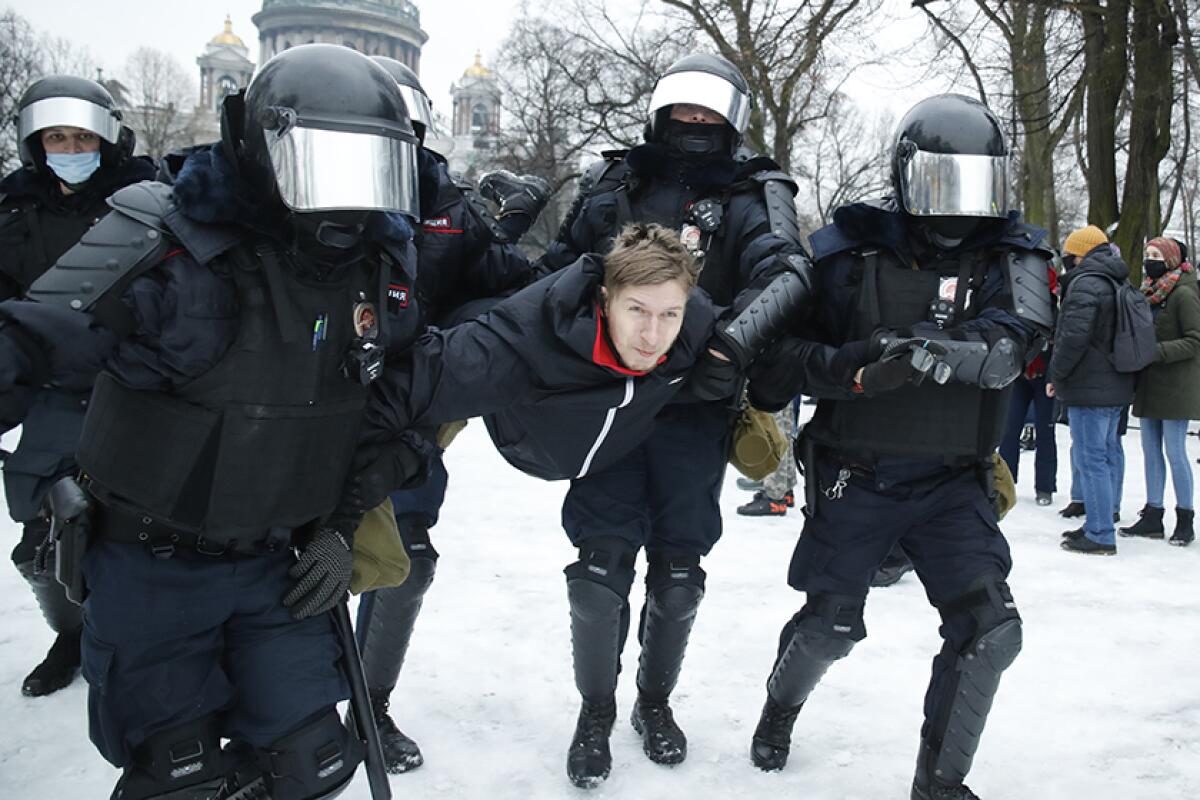3,000 arrested in Russia at protests demanding Navalnyâs release

MOSCOW â Protests erupted in dozens of cities across Russia on Saturday to demand the release of opposition leader Alexei Navalny, the Kremlinâs most prominent foe. Police arrested more than 3,000 people, some of whom took to the streets in temperatures as frigid as minus-58 degrees Fahrenheit.
In Moscow, an estimated 15,000 demonstrators filled Pushkin Square in the city center, where clashes with police broke out and demonstrators were roughly dragged off by helmeted riot officers to police buses and detention trucks, some beaten with batons.
Navalnyâs wife, Yulia, was among those arrested.
Police eventually pushed demonstrators out of the square. Thousands regrouped along a wide boulevard about half a mile away, many of them throwing snowballs at the police before dispersing.
The protests stretched across Russiaâs vast territory, from the island city of Yuzhno-Sakhalinsk north of Japan and the eastern Siberian city of Yakutsk, where temperatures plunged to minus-58 degrees Fahrenheit, to Russiaâs more populous European cities. The range demonstrated how Navalny and his anti-corruption campaign have built an extensive network of support despite official government repression and being routinely ignored by state media.
âThe situation is getting worse and worse. Itâs total lawlessness,â said Andrei Gorkyov, a protester in Moscow. âAnd if we stay silent, it will go on forever.â
The OVD-Info group, which monitors political arrests, said at least 1,167 people were detained in Moscow and more than 460 at another large demonstration in St. Petersburg. Overall, it said 3,068 people had been arrested in some 90 cities. Russian police did not provide arrest figures.
Undeterred, Navalnyâs supporters called for protests again next weekend.
Navalny was arrested Sunday when he returned to Moscow from Germany, where he had spent five months recovering from a severe nerve-agent poisoning that he blames on the Kremlin and that Russian authorities deny. Authorities say his stay in Germany violated terms of a suspended sentence in a 2014 criminal conviction, while Navalny says the conviction was for made-up charges.
The 44-year-old activist is well known nationally for his reports on the corruption that has flourished under President Vladimir Putinâs government.
His wide support puts the Kremlin in a strategic bind â risking more protests and criticism from the West if it keeps him in custody but apparently unwilling to back down by letting him go free.
Navalny faces a court hearing in early February to determine whether his sentence in the criminal case for fraud and money-laundering â which Navalny says was politically motivated â is converted to 3½ years behind bars.
Moscow police on Thursday arrested three top Navalny associates, two of whom were later jailed for periods of nine and 10 days.
Navalny fell into a coma while aboard a domestic flight from Siberia to Moscow on Aug. 20. He was transferred from a hospital in Siberia to a Berlin hospital two days later. Labs in Germany, France and Sweden, and tests by the Organization for the Prohibition of Chemical Weapons, established that he was exposed to the Soviet-era Novichok nerve agent.
Russian authorities insisted that the doctors who treated Navalny in Siberia before he was airlifted to Germany found no traces of poison and have challenged German officials to provide proof of his poisoning. Russia refused to open a full-fledged criminal inquiry, citing a lack of evidence that Navalny was poisoned.
Last month, Navalny released the recording of a phone call he said he made to a man he described as an alleged member of a group of officers of the Federal Security Service who purportedly poisoned him in August and then tried to cover it up. The service dismissed the recording as fake.
Navalny has been a thorn in the Kremlinâs side for a decade, unusually durable in an opposition movement often demoralized by repressions.
He has been jailed repeatedly in connection with protests and twice was convicted of financial misdeeds in cases that he said were politically motivated. He suffered significant eye damage when an assailant threw disinfectant into his face. He was taken from jail to a hospital in 2019 with an illness that authorities said was an allergic reaction but which many suspected was poisoning.
More to Read
Sign up for Essential California
The most important California stories and recommendations in your inbox every morning.
You may occasionally receive promotional content from the Los Angeles Times.










